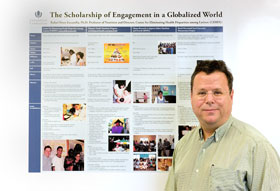  |
| HOME | THIS ISSUE | CALENDAR | GRANTS | BACK ISSUES | < BACK | NEXT > |
Nutrition expert maps hunger in Brazil via nationwide studyby Scott Brinckerhoff - October 16, 2006 |
||||
| Three years ago, nutritional sciences professor Rafael Pérez-Escamilla was running a focus group in Brazil, when one of the participants, who had been listening quietly, rose from his seat and addressed the group: "You really want to know what hunger is?" he said. "It's the worst a person can suffer. It's the worst form of violence. It's the worst thing you can to do the dignity of a human being." For decades, Pérez-Escamilla has been studying the subject of hunger, or "food insecurity," as social scientists label it in a broader sense. But until that day, he had never heard the topic expressed so poignantly. "The testimony that day still moves me," he says. "Food insecurity" is the inability to access nutritional food in sufficient quantities without resorting to socially unacceptable means. Pérez-Escamilla and a team of Brazilian researchers recently completed a landmark study of food insecurity in Brazil. The study, using a U.S. Department of Agriculture (USDA) research tool, attracted very positive attention and follow-up action from the Brazilian government. The tool is now being adapted by other Latin American countries to scientifically study their own food insecurity issues. Pérez-Escamilla has conducted extensive studies of community nutrition and food insecurity among inner-city Latino populations in the U.S. He became involved in food insecurity issues in Brazil in 2003, when he took a sabbatical leave at the University of Campinas. At that time, the country's new president, Luiz Inácio Lula da Silva, was moving to fulfill a campaign promise to eradicate hunger: "Fome Zero" (Zero Hunger) was becoming a national mantra. But in Brazil, a vast country of contrasts in race, class, wealth, industry, and agriculture, policy makers realized they first needed to assess the extent of food insecurity. Under the leadership of Pérez-Escamilla and Professor Ana Maria Segall-Corrêa of the University of Campinas, a team of academics and policy makers assembled to study the problem. Pérez-Escamilla was the only non-Brazilian team member. "It was obvious that food insecurity was a huge problem in Brazil," he says. "Many, many people didn't have access to a diet of sufficient quality, and sometimes quantity, through acceptable means. But knowing this anecdotally and knowing it scientifically are two different things.
"If people have to depend on welfare or garbage dumps, that's not good enough," he adds. "If they are skipping meals, adding water to milk, and relying mostly on rice and pasta instead of meat, vegetables, and fruit, that's food insecurity. If children are going whole days without food, that's hunger." Pérez-Escamilla and Segall-Corrêa had worked together on hunger issues since the early 1990s. The two were the core of a team that coordinated the national adaptation and validation of the USDA tool in the Brazilian context, a task that involved translating it into Portuguese and dropping such ambiguous terms as "balanced meals" in favor of "healthy and varied diet." Respondents were asked questions such as, "During the last three months, were you worried that you would run out of food before being able to buy, receive, or produce more food? Were you unable to offer your children a healthy or varied diet because you didn't have enough money (or food production)? Did you skip meals? Lose weight because of lack of food? What started as a series of small qualitative and quantitative studies culminated in a major national survey in 2004 that collected food insecurity data in 120,000 households throughout Brazil. The final report was released recently in Brazil, where it has attracted national attention and even figured in the recent presidential election. Using statistical tools, the results have been parsed extensively over many pages. Some of the primary findings are that about 65 percent of the households see themselves as "food secure," while some 6.5 percent - about 14 million people - experience severe hunger. Rural households with young children and "afro descendant" households have especially high rates of food insecurity. Pérez-Escamilla says the Brazilian government appears committed to addressing food insecurity through a number of strategies, including income redistribution, a milk program for children, and soup kitchens where people can receive a nutritious meal for little or no money. "It has been encouraging to see the government - left, right, and center - rally behind the idea of taking steps to eliminate food insecurity," he says. "Food security is being seen in Brazil as a human right involving access to work, health, education, housing, and income. The government is using our study for guidance as it moves forward in all these areas.
|
| ADVANCE HOME UCONN HOME |

